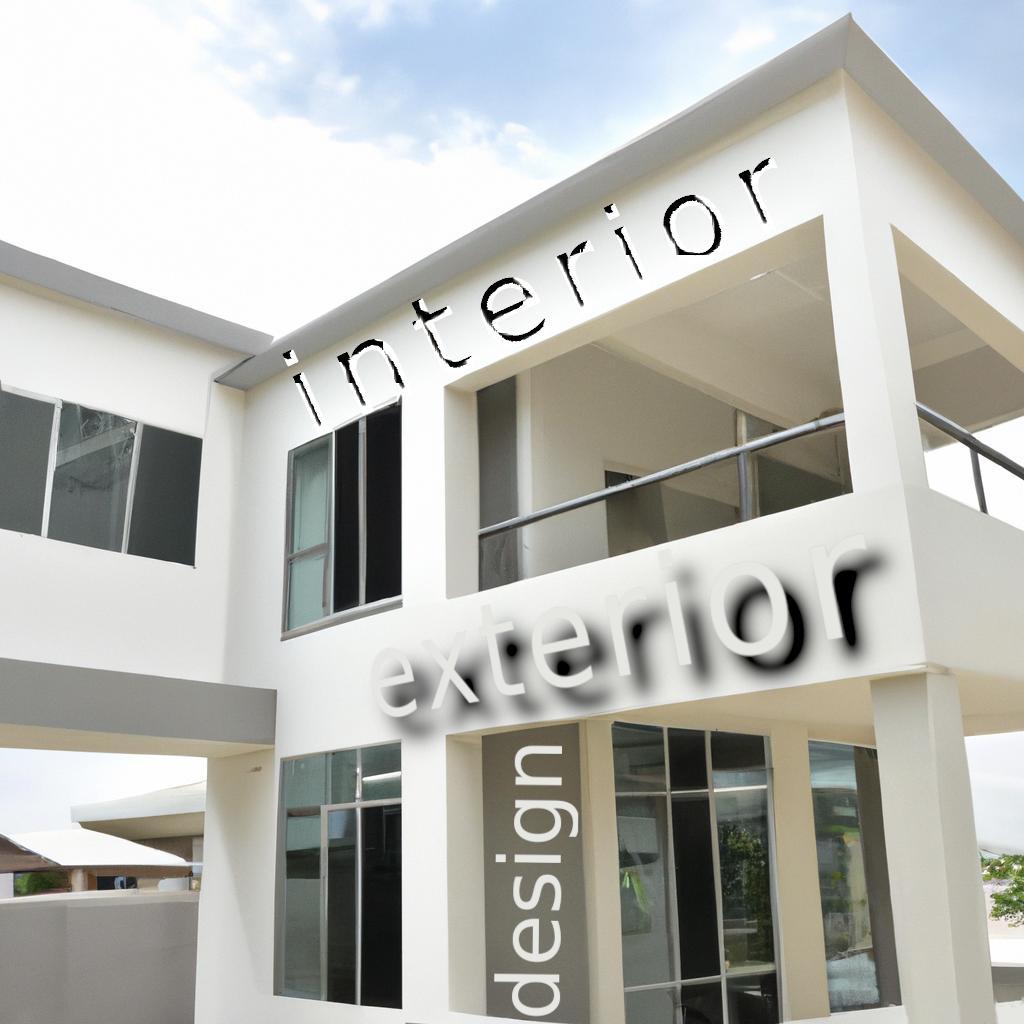


In the realm of architecture, the dance between interior and exterior design is a symphony that transforms structures into lived experiences. From the cozy corners of living rooms to the commanding facades of skyscrapers, the artistry of design defines the spaces we inhabit. Let's embark on a journey into the enchanting world of interior and exterior design, where aesthetics, functionality, and innovation converge to shape the visual tapestry of our built environment.
The Gateway to Aesthetics: The Facade as Architectural Poetry
The exterior facade of a building is akin to the cover of a captivating book—it sets the tone for what lies within. Modern architecture embraces a myriad of design philosophies, from sleek glass curtain walls that reflect the urban landscape to avant-garde structures that challenge traditional norms. The facade becomes a canvas for architects to showcase creativity, blending form and function in a harmonious expression of architectural poetry.
Nature and Nurture: The Serenity of Outdoor Design
Exterior design extends beyond concrete walls to embrace the natural world. Outdoor spaces, whether expansive landscapes or intimate urban gardens, become extensions of living spaces. Landscape architects weave together elements of flora, fauna, and hardscaping to create serene environments that invite inhabitants to connect with nature. The alchemy of outdoor design transforms a simple yard into a sanctuary of tranquility.
The Art of Entrance: Doorways as Portals to Personality
The entryway of a home or building is the threshold where design welcomes its guests. Grand entrances adorned with intricate detailing, modern pivot doors that exude minimalist elegance, or vibrant colors that evoke a sense of warmth—all contribute to the narrative of a space. Door design becomes a portal to the personality within, inviting individuals to step into a world crafted with intention and design finesse.
Spatial Symphony: The Interplay of Interior Elements
Step beyond the threshold, and interior design takes center stage, orchestrating a spatial symphony that harmonizes functionality with aesthetics. From open-concept living areas that encourage social interaction to cozy nooks designed for introspection, the interior becomes a canvas for creating atmospheres that cater to the needs and desires of its occupants. Color palettes, furniture arrangements, and lighting designs are the notes in this design symphony.
Form Follows Function: The Modernist Approach to Interior Efficiency
Modern interior design embraces the mantra of "form follows function," focusing on efficiency without compromising aesthetics. Minimalist furniture, multifunctional spaces, and clever storage solutions contribute to the creation of interiors that are both visually pleasing and purposefully practical. The modernist approach celebrates simplicity, ensuring that each element serves a functional purpose while contributing to the overall design ethos.
Technological Tapestry: Smart Design for a Connected Lifestyle
In the age of smart homes and interconnected living, technology seamlessly weaves itself into the fabric of interior design. Smart lighting, integrated home automation systems, and cutting-edge appliances transform living spaces into hubs of technological convenience. The design incorporates the latest innovations, creating homes that respond intelligently to the needs and preferences of their inhabitants.
Texture and Touch: The Tactile Experience of Interior Elements
Interior design is not merely visual; it's a multisensory experience that includes the tactile qualities of materials. From the soft caress of plush carpets underfoot to the cool touch of marble countertops, designers curate textures that enhance the sensory journey within a space. The interplay of materials becomes a narrative, inviting individuals to engage with and appreciate the physicality of their surroundings.
Harmony in Holism: Cohesive Interior and Exterior Relationships
The most enchanting designs are those where the boundary between interior and exterior blurs, creating a seamless transition. Floor-to-ceiling windows that dissolve barriers, outdoor living rooms that extend indoor comforts, and materials that flow effortlessly from exterior to interior—all contribute to the holistic harmony of design. The relationship between inside and outside becomes a dance of continuity, enriching the overall experience of the space.
Interior design is the art and science of enhancing the interior of a building to achieve a healthier and more aesthetically pleasing environment for the people using the space. It involves designing and decorating the interior spaces of homes, offices, restaurants, hotels, and other commercial buildings. The goal of interior design is to create functional, comfortable, and visually appealing spaces that meet the needs of the occupants.
Some of the elements of interior design include color schemes, lighting, furniture, fabrics, flooring, and accessories. Interior designers use these elements to create a cohesive and harmonious space that reflects the client's personal style and meets their functional requirements.
Here are some recent interior design innovations and perspectives:
Sustainable Design: There is a growing emphasis on sustainability in interior design, with designers seeking out eco-friendly materials and practices, such as using recycled materials, reducing waste, and designing for energy efficiency.
Biophilic Design: This approach incorporates natural elements, such as plants, water features, and natural light, into interior design, creating spaces that are more calming, restorative, and supportive of human well-being.
Multi-functional Spaces: With more people working from home and living in smaller spaces, there is a trend towards creating multi-functional spaces that can serve multiple purposes, such as a home office that doubles as a guest room.
Smart Home Technology: The integration of smart home technology, such as voice-activated assistants, automated lighting and temperature control, and integrated entertainment systems, is becoming more common in interior design.
Customization and Personalization: Interior designers are increasingly working with clients to create customized and personalized spaces that reflect their unique tastes, preferences, and lifestyles.
Bold Colors and Patterns: There is a growing trend towards using bold colors and patterns in interior design, creating spaces that are more vibrant and expressive.
Minimalism: This approach emphasizes simplicity, functionality, and a pared-down aesthetic, with designers using fewer, high-quality items and a neutral color palette.
Artisanal and Handmade Items: There is a renewed appreciation for artisanal and handmade items in interior design, with designers seeking out unique, one-of-a-kind pieces that add character and personality to a space.
Industrial Design: This approach draws inspiration from industrial spaces, with designers incorporating raw materials, exposed brick and ductwork, and utilitarian objects into interior design.
Wellness Design: This approach focuses on creating spaces that promote physical and mental well-being, with designers incorporating features such as air-purifying plants, ergonomic furniture, and spaces for meditation and relaxation.
Exterior design, on the other hand, is the art and science of designing the outdoor spaces of a building, including the façade, landscaping, outdoor lighting, and other elements. The goal of exterior design is to create an attractive and welcoming building exterior that complements the surrounding environment and enhances the building's curb appeal.
Exterior design elements may include the building's architecture, materials, colors, landscaping, hardscaping, outdoor furniture, and lighting. Exterior designers use these elements to create a visually appealing and functional outdoor space that meets the needs of the building's occupants and visitors. Overall, interior and exterior design work together to create a harmonious and cohesive building that reflects the client's vision and meets their needs.
Here are some recent exterior design innovations and perspectives:
Sustainable Design: Similar to interior design, there is a growing emphasis on sustainability in exterior design, with designers seeking out eco-friendly materials and practices, such as green roofs, permeable paving, and rainwater harvesting.
Biophilic Design: The incorporation of natural elements into the exterior design, such as landscaping and green spaces, is becoming more popular, creating environments that are more visually appealing and supportive of human well-being.
Outdoor Living Spaces: There is a trend toward creating outdoor living spaces that are an extension of the interior living space, such as outdoor kitchens, fire pits, and seating areas.
Smart Home Technology: The integration of smart home technology, such as outdoor lighting, irrigation systems, and security cameras, is becoming more common in exterior design.
Sustainable Landscaping: There is an increasing emphasis on sustainable landscaping practices, such as using native plants and designing landscapes that require minimal water and maintenance.
Modern Minimalism: This approach to exterior design emphasizes simplicity, clean lines, and a minimalist aesthetic, with designers using a limited color palette and minimal ornamentation.
Industrial Design: Similar to interior design, industrial design elements, such as exposed brick and metalwork, are being incorporated into the exterior design, creating a unique and industrial-chic aesthetic.
Mixed Materials: Designers are using a mix of materials, such as stone, wood, and metal, to create visually interesting and textured exterior facades.
Bold Colors: There is a trend toward using bold and vibrant colors on exterior walls, doors, and accents, creating eye-catching and unique designs.
Eco-Friendly Building Materials: New building materials, such as recycled plastic composites and bio-based materials, are being developed that have a lower environmental impact than traditional building materials.
Hiring an interior or exterior designer can be an excellent investment in your property, but it's essential to do your research and choose the right designer for your project. Here are some things to consider when hiring an interior or exterior designer:
Style and expertise: Look for a designer who has experience in the specific style you're looking for. Check their portfolio and past projects to see if their aesthetic matches your preferences. Also, make sure they have experience in the type of project you're working on, whether it's a residential or commercial property.
Communication skills: Good communication is crucial when working with a designer. They should be able to listen to your needs and ideas, provide feedback and suggestions, and keep you updated on the progress of the project. Make sure you feel comfortable communicating with the designer and that they are responsive to your questions and concerns.
Budget and timeline: Make sure you have a clear understanding of the designer's fees and expenses, as well as the timeline for the project. Be upfront about your budget and timeline expectations and make sure the designer can work within those parameters.
Credentials and licensing: Check if the designer has the necessary credentials and licensing to work on your project. They should have completed a relevant design program and be licensed to practice in your area.
References and reviews: Ask the designer for references from past clients and check their online reviews to get a sense of their reputation and quality of work.
Contracts and agreements: Before starting the project, make sure you have a written contract or agreement that outlines the scope of work, fees, timeline, and other important details. This will help ensure that both you and the designer are on the same page and can avoid any misunderstandings or disputes.
The magic of design lies in its ability to transform spaces into living artworks. Interior and exterior design, each with its unique language, converge to create environments that tell stories, evoke emotions, and cater to the needs of those who inhabit them. From the grandeur of facades to the intimate details within, the art and alchemy of design shape the world we live in, turning structures into living, breathing expressions of human creativity.
Have a good design,

We use cookies
We use cookies and other tracking technologies to improve your browsing experience on our website, to show you personalized content and targeted ads, to analyze our website traffic, and to understand where our visitors are coming from. Privacy Policy.